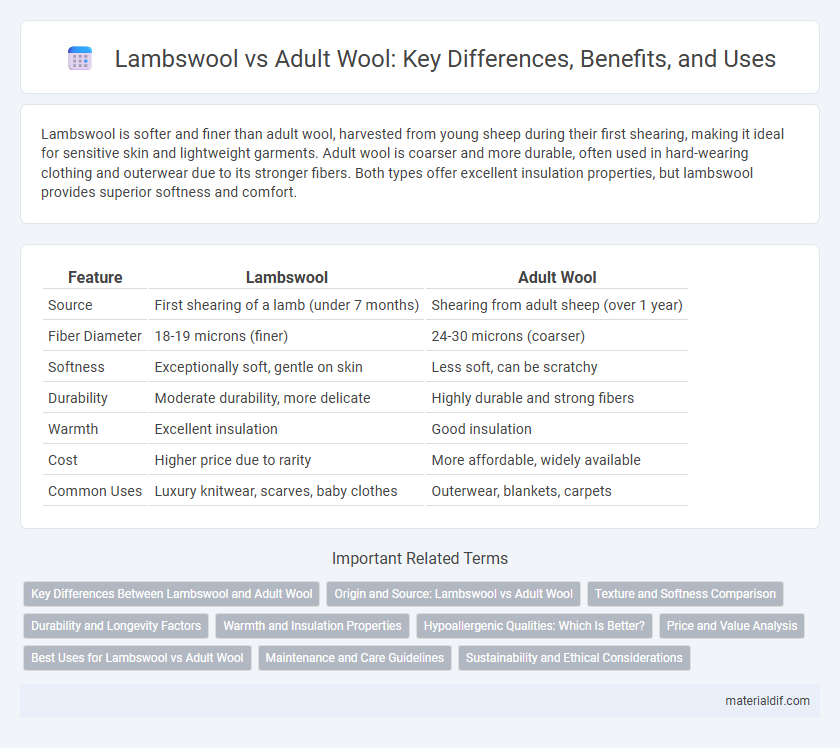Lambswool is softer and finer than adult wool, harvested from young sheep during their first shearing, making it ideal for sensitive skin and lightweight garments. Adult wool is coarser and more durable, often used in hard-wearing clothing and outerwear due to its stronger fibers. Both types offer excellent insulation properties, but lambswool provides superior softness and comfort.
Table of Comparison
| Feature | Lambswool | Adult Wool |
|---|---|---|
| Source | First shearing of a lamb (under 7 months) | Shearing from adult sheep (over 1 year) |
| Fiber Diameter | 18-19 microns (finer) | 24-30 microns (coarser) |
| Softness | Exceptionally soft, gentle on skin | Less soft, can be scratchy |
| Durability | Moderate durability, more delicate | Highly durable and strong fibers |
| Warmth | Excellent insulation | Good insulation |
| Cost | Higher price due to rarity | More affordable, widely available |
| Common Uses | Luxury knitwear, scarves, baby clothes | Outerwear, blankets, carpets |
Key Differences Between Lambswool and Adult Wool
Lambswool is prized for its softness and fine fibers, typically harvested from sheep under seven months old, making it warmer and less itchy than adult wool. Adult wool, sourced from mature sheep, contains coarser fibers, offering greater durability and insulation but with a rougher texture. These key differences impact garment comfort, performance, and price, with lambswool favored for luxury and softness, while adult wool suits hard-wearing, practical uses.
Origin and Source: Lambswool vs Adult Wool
Lambswool is sourced from the first shearing of a sheep, typically around seven months old, resulting in finer, softer fibers due to the young age of the animal. Adult wool comes from mature sheep that have been sheared multiple times, yielding coarser and thicker fibers with greater durability. The origin of lambswool is highly valued for its softness and elasticity, while adult wool is prized for strength and longevity in textiles.
Texture and Softness Comparison
Lambswool, harvested from the first shearing of a young sheep, is renowned for its exceptionally fine texture and superior softness compared to adult wool. The fibers of lambswool typically measure under 19 microns, providing a smooth, plush feel ideal for sensitive skin and luxury garments. In contrast, adult wool has coarser fibers averaging 20 to 30 microns, resulting in a tougher texture that offers durability but less softness.
Durability and Longevity Factors
Lambswool, harvested from the first shearing of young sheep, offers exceptional softness but less durability compared to adult wool, which comes from mature sheep and has coarser fibers that enhance its strength and longevity. The finer fibers in lambswool are prone to pilling and wear, making it ideal for lightweight, delicate garments but less suited for heavy use. Adult wool's robust fiber structure provides superior resistance to abrasion and maintains fabric integrity over extended periods, making it more durable for outerwear and heavy-duty textiles.
Warmth and Insulation Properties
Lambswool, harvested from young sheep under one year old, offers superior softness and excellent insulation due to its finer fibers, making it exceptionally warm and comfortable for sensitive skin. Adult wool, while coarser, provides greater durability and enhanced moisture-wicking properties, contributing to effective temperature regulation and long-lasting warmth. Both types of wool excel in thermal insulation, but lambswool is preferred for lightweight warmth, whereas adult wool suits heavy-duty insulation needs.
Hypoallergenic Qualities: Which Is Better?
Lambswool is typically more hypoallergenic than adult wool due to its finer fibers, which cause less irritation and allergic reactions on sensitive skin. Adult wool contains coarser fibers that may trigger itching or allergies in individuals prone to sensitivities. Choosing lambswool enhances comfort and reduces the risk of skin inflammation for allergy sufferers.
Price and Value Analysis
Lambswool, harvested from sheep under seven months old, commands a higher price due to its softness, fineness, and superior insulating properties compared to adult wool. Adult wool is coarser and less elastic, offering greater durability but at a lower cost, making it more suitable for budget-conscious consumers prioritizing longevity over luxury. Consumers seeking premium comfort and softness often invest in lambswool, while those focusing on value and utility tend to choose adult wool for more affordable, hard-wearing products.
Best Uses for Lambswool vs Adult Wool
Lambswool, sourced from the first shearing of a young sheep, is finer, softer, and more elastic, making it ideal for next-to-skin garments like sweaters, scarves, and baby clothing where comfort and softness are paramount. Adult wool, which comes from mature sheep, is coarser and more durable, making it better suited for outerwear, rugs, and upholstery that require resilience and insulation. Choosing lambswool benefits sensitive skin and lightweight apparel, while adult wool excels in heavy-duty applications demanding longevity and warmth.
Maintenance and Care Guidelines
Lambswool, sourced from the first shearing of a lamb, requires gentle washing with cool water and mild detergents to maintain its softness and prevent shrinkage. Adult wool, being coarser and more durable, can tolerate slightly warmer water and more rigorous cleaning methods but still benefits from careful hand washing or dry cleaning to preserve fiber strength and reduce felting. Both types should be air-dried flat away from direct heat to maintain shape and longevity.
Sustainability and Ethical Considerations
Lambswool, harvested from sheep under one year old, is prized for its softness and warmth but raises sustainability concerns due to shorter fiber longevity and higher consumption per garment compared to adult wool. Adult wool, sourced from mature sheep, offers greater durability and often comes from more sustainable farming practices focused on animal welfare and reducing environmental impact. Ethical considerations in both cases emphasize cruelty-free shearing methods and support for regenerative agriculture to ensure long-term ecosystem health.
Lambswool vs Adult Wool Infographic

 materialdif.com
materialdif.com